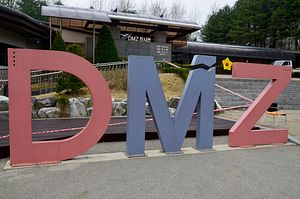North Korea has threatened “to retaliate against the U.S. with tremendous muscle” if the latter doesn’t cancel military exercises scheduled to begin tomorrow. The exercises are going ahead as planned. Earlier in the month, two South Korean soldiers were wounded along the border with North Korea. The blast came from landmines placed along a regular patrol route. The attack quickly produced a response, with the South resuming propaganda exercises within the North.
The North has once again turned to provocations and bellicosity in a bid to gain international attention. This is hardly unexpected, as it fits within a longstanding pattern of actions around the Demilitarized Zone (DMZ).
But after years of threatening violence, the North faces a situation where threats alone were producing diminishing returns. Where once nuclear threats were treated with the utmost gravity and pledges to attack South Korea made the North international enemy number one, the world has essentially stopped listening. As a result, actually engaging in violence is the only real method the North has left to sustain the diplomatic returns it seeks.
As an example of this trend, one need only look at the abductions of U.S. citizens. In 2009, North Korea’s abductions of Euna Lee and Laura Ling brought a visit from former U.S. President Bill Clinton. But when Pyongyang held Kenneth Bae and Matthew Todd Miller, Washington dispatched James Clapper, a non-cabinet level official, to bring them home. Each time North Korea introduces a new strategy, it steadily produces smaller gains.
With actual violence, though, the story is very different. Targeted applications of force by the North do not produce diminishing returns. For example, when the North sank the ROKS Cheonan in 2010, it resulted in the new round of public threats being taken much more seriously. As such, it would be no surprise to see Kim Jong-un use violence to pursue his aims.
And the North often makes the DMZ the focus of its action. The Cheonan, for example, was attacked near the Northern Limit Line, essentially the maritime extension of the DMZ. In bombing Yeonpyeong Island late in 2010, North Korea also chose a target close to the border.
Pyongyang often links violence to diplomacy. Take, for example, the axe murder incident of 1976, in which North Korean soldiers killed two U.S. Army officers. Within hours of the action, Kim Jong-Il, then a functionary under his father, addressed a conference of the Non-Aligned Movement in Sri Lanka where he presented a document labeling the event an “unprovoked attack” by the United States. He then moved a motion condemning the United States. Back in 1976, the North had many more friends than it does today, and the motion passed. The axe used to murder the two Americans is presently on display in North Korea.
Following this most recent incident, South Korea has vowed a “harsh” response. But calibrating a response is not that easy – the perception is that Seoul’s response to the Cheonan sinking was relatively weak. Although the North is unlikely to find the friends it had in 1976, it still has a degree of diplomatic support from China that makes leveraging a diplomatic response more complicated. The need to establish deterrence has to be balanced against the need to avoid a degenerating security situation.
As a result, the South faces a significant policy conundrum. Still, it has options, such as trying to expand the space of civil society within North Korea, where the government does not maintain full control.
The most likely scenario is a fresh drive for sanctions and a cooling of economic engagement between the two states. It remains to be seen, however, if this is the best option going forward. An alternative for Seoul might be to develop information links into North Korea to push an anti-Kim message (and the propaganda response already announced certainly sits within this). It is also possible to undermine Kim’s ability to travel and to have allied states deny North Korea the right to maintain embassies in their countries. Which options the South chooses this time is difficult to ascertain. In the meantime, though, is that the trend of violence on the border is well established and should be expected to continue.
Robert Potter is a PhD candidate at the University of Queensland.

































